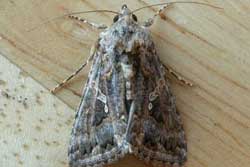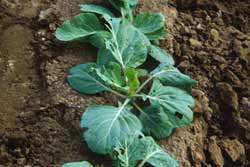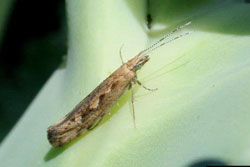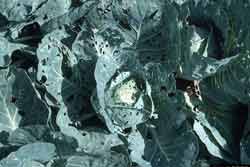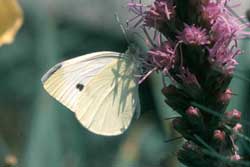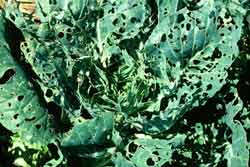Cabbage Worms
On this page:
- Cabbage Looper—Trichoplusia ni
- Diamond Back Moth—Plutella xylostella
- Imported Cabbageworm—Pieris rapae
Three caterpillars can be voracious pests of cabbage, broccoli and other cole crops*. If allowed to become numerous they can completely defoliate plants. Minor infestations make plants look unsightly and can cause reduced yields and increased decay.
In addition to cole crops, the cabbage looper may also feed on lettuce, soybeans, tomatoes and some annual flowers.
(*Brassica is a genus of plants in the Brassicaceae family. Crops from this family are sometimes called cole crops, which comes from the Latin for stem or cabbage. Vegetables of this family are called cruciferous vegetables or crucifers because the four petals of their flowers resemble a cross. Brassicas, cole crops, and crucifers are all terms refering to cabbage, broccoli, cauliflower, Brussels sprout, turnip, kale, radish, rutabaga, collards and the like.)
Cabbage Looper—Trichoplusia ni
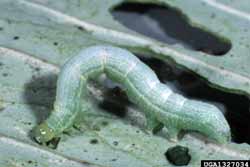
The cabbage looper larvae grow to about 2 inches, and are light green with a few white or pale yellow stripes. They move with a characteristic "looping" motion similar to inchworms.
Diamondback Moth—Plutella xylostella
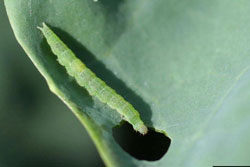
Diamondback moth larvae are 1/4 to 1/3 inch long, tapered at both ends, pale yellowish-green, with fine, scattered black hairs over the body and a black head. They wriggle rapidly when disturbed, often dropping from the plant and hanging by a silk-like thread.
Imported Cabbageworm—Pieris rapae
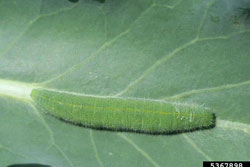
The imported cabbageworm larvae is velvety green, about 1 inch long, and tends to be sluggish. They feed and rest on the underside of leaves.
Click on images to view full-size
Identification and Control Information
- Pest Management Fact Sheet: Imported Cabbageworm—University of Maine Cooperative Extension
- Caterpillar Pests of Cole Crops in Home Gardens (PDF)—University of Minnesota Extension Service
- Insects of Crucifers: Cabbage Looper (PDF)—Cooperative Extension New York State, Cornell University
- Wisconsin Garden Facts: Cabbage Looper (PDF)—University of Wisconsin-Extension
- Insects of Crucifers: Diamondback Moth (PDF)—Cooperative Extension New York State, Cornell University
- Insect Pests of the Home Garden Fact Sheet: Diamondback Moth (PDF)—New Jersey Rutgers Cooperative Research & Extension
- Imported Cabbageworm (PDF)—Insect Diagnostic Laboratory Cornell University
[Photos, left to right: Alton N. Sparks, Jr., University of Georgia, Bugwood.org; Keith Naylor, Bugwood.org; David Riley, University of Georgia, Bugwood.org; Russ Ottens, University of Georgia, Bugwood.org; Russ Ottens, University of Georgia, Bugwood.org; Alton N. Sparks, Jr., University of Georgia, Bugwood.org; Russ Ottens, University of Georgia, Bugwood.org; Whitney Cranshaw, Colorado State University, Bugwood.org; Whitney Cranshaw, Colorado State University, Bugwood.org]
